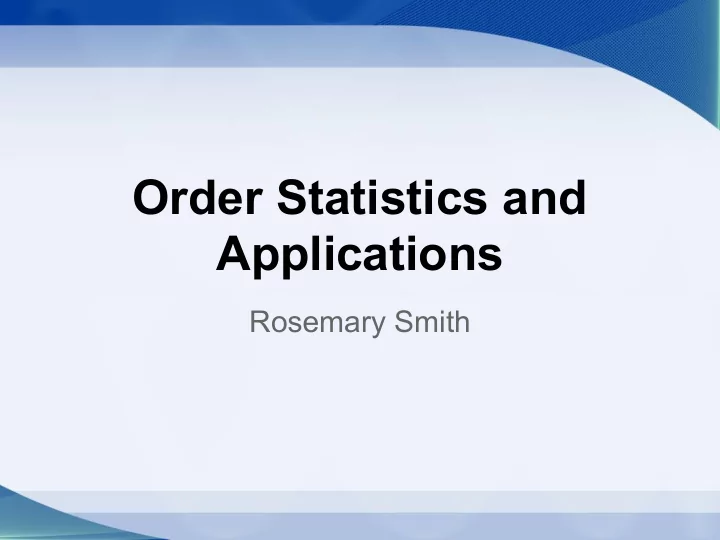

Order Statistics and Applications Rosemary Smith
Introduction to Order Statistics ● Unordered Statistics and Observations ● Ordered Statistics and Observations
What kinds of problems are we trying to solve? ● Actuarial Science ○ Joint Life Insurance - A policy for a couple pays out when the first of the spouses dies. You want to know the distribution of , which is the random variable defined to be the minimum of two lifespans of the couple. ○ Insurance Risk - If an insurance company holds 100 policies of which you have cash-at-hand to pay 50. You want to know the distribution of the variable the 50th occurrence of a pay-out.
What kinds of problems are we trying to solve? ● Industry ○ A machine may run on 10 batteries and shuts off when the 5th battery dies. You will want to know the distribution of . ○ The same machine becomes less efficient when the third battery dies and costs you money every day it runs that way. You then want to know the distribution of ,the range between the third and fifth occurrences.
Further Definitions ● Probability distribution ● Cummulative distribution ● Probability Distribution of ● Cummulative Distribution of
Further Definitions ● Joint distribution of and ● Cumulative Joint Distribution ● The Range ● Expected value of
Deriving We will assume the variables are i.i.d. ● First to derive ● Now to derive
General Formula ● Formula for
Deriving ● By thinking about where we need the variables to land in order to get a specified x and y value we can understand where the formula for the joint distribution comes from
Deriving ● Logically we want to integrate over all of the points that give us the desired range. This we can do since we have a formula for the joint distribution of two order statistics.
Formula For ● We start with the standard formula for expected value ● Many people take the below formula and change variables to simplify.
Example:Batteries ● Consider a machine that uses 10 batteries. Because it has so many, it doesn’t shut off until half of the batteries are dead. ○ Given the batteries all have a uniform distribution on the interval [.5, 1] years, what is the probability that the machine dies before .75 years? What is the expected time when the fifth battery will die? ● Running the machine with 3 dead batteries lowers efficiency and costs $1 a day. ○ How much money will the company spend between the 3rd battery death and the 5th battery death? This entails finding the range .
Example:Batteries Here n=10, k=5
Example:Batteries To calculate expected value we need:
Example:Batteries What is the expected value of ?
Resources ● Sean Ballentine ● Order Statistics by H. A. David ● Probability and Statistical Inference by Robbert V. Hogg and Elliot A. Tanis
Recommend
More recommend